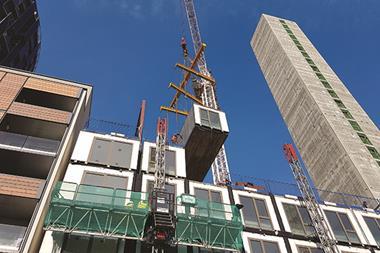Modular construction has great potential as a major UK export, according to the government’s recent industrial strategy, but the truth is there is some way to go.

Momentum is building, with most housebuilders delivering at least one development with an element of modular construction. However, countries such as Sweden and Japan are streets ahead, with around 40% and 16% of their new residential buildings, respectively, involving offsite construction.
On Built-ID, our members showcase more than 100 modular projects and it is telling that the majority of the most ambitious designs we feature were commissioned overseas.
One of the standout exceptions is HTA Design and Tide Construction’s 101 George Street in Croydon, which is set to become the world’s tallest modular building. Another of my favourites is Urban Splash and shedkm’s modular housing offering, which exemplifies the flexibility and personalisation that offsite construction can bring to the market.

A key problem is volume and supporting infrastructure. With the annual number of new modular homes standing at just 15,000, it is difficult to see how we will reach the government’s target of 100,000 by 2020 without major investment in modern, highly automated factories.
That said, it is encouraging to see an industry leader such as Legal & General getting behind the technology with a drive to increase supply. In the past, we have mainly seen satellite production facilities spring up next to major developments, but L&G’s impressive Leeds factory takes it to another level in terms of scale and ambition. It is the commitment to building factories such as this, as much as the modular schemes themselves, that will make or break the UK offsite construction industry.
Speed of production is also closely aligned with housing delivery figures and right now, it is on the slow side. Add to that the huge upfront costs and you can see why housebuilders are erring on the side of caution. The strength of their order books will dictate the ease of adoption.
In terms of dense urban locations, while modular housing is the dream solution in many ways, there are still some challenges. If you don’t have the option of creating an onsite factory, the logistics of transporting the units to the site will always be a precision job, considering disruption caused by road closures and traffic congestion.
Rising to the challenge
While the challenge is significant, I think it is one the industry can and should rise to. There will be major advantages to the economy, property players, the environment and a society in the throes of a housing crisis.
The government’s push for the UK to step up modular construction is hardly surprising, given the vast cost and time savings on offer. Some of the best products use steel-frame volumetric systems for faster build times, for example HTA and Tide’s 29-storey Apex House, which went up in just 12 months.
Volumetric technology can also produce factory-made units that easily stack on top or alongside one another, creating significant flexibility. The Y:Cube by Roger Stirk Harbour + Partners is the perfect example; the modules can slot together in various arrangements according to the space available.
Find out more - Modular construction: all mod cons
I could go on all day about modular construction’s potential benefits. It helps mitigate against the skilled worker shortage that is pushing up the costs of traditional construction. The automated factory environment enables strict quality control, which is so crucial to achieving environmental standards such as BREAAM, as well as creating safer working conditions.
This type of construction might even mitigate against the often-fraught relationship between the developer and the community, as it requires less time on site, disruption, noise and waste.
The government should continue to offer incentives and invest in the necessary infrastructure, especially if it is serious about using the technology to make a dent in the housing crisis. We still need to catch up in terms of productivity, before we can even think about becoming a global leader in offsite construction.






























No comments yet